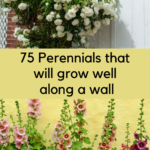When people hear that I spend my free time gardening and my work days writing about gardening, they assume I must have the perfect garden. This couldn’t be further from the truth; although I constantly fantasize about having the ideal layout, as I’m sure most gardeners do.
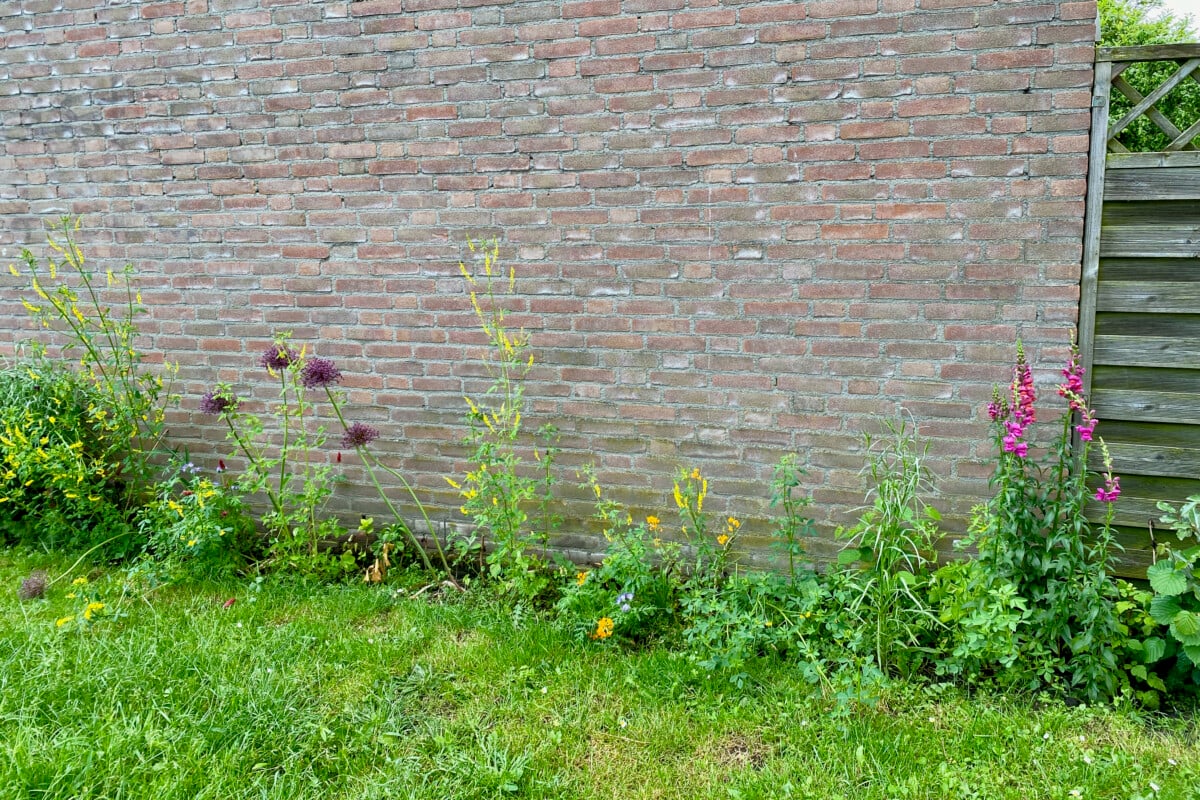
What I do have are awkward spaces, plenty of constraints and a climate that’s starting to verge on unpredictable.
So I’m quickly becoming a reluctant gardener, trying to make the best I can out of difficult spots. One such space that I’m planning on rehauling is the small strip of soil along a wall. There’s not much soil there and it barely gets any direct sunlight, so it’s a challenge
If you’re also struggling with gardening within these limitations, I’ve done the research to show you what plants can grow along a wall.
Can you garden against a wall?
Growing plants against a wall is tricky, even when you know what you’re doing. But especially if you don’t know the limitations of this space. Fortunately, it’s also a great way to add more growing space to your yard, hide an unsightly wall or add more visual interest to an otherwise drab and uniform surface.
So yes, you can create a narrow garden against a wall. But before we talk about what plants will grow well along a wall, here are a few things you should think about.
3 Things to Consider When You’re Planting Along a Wall.
1. Think of the area alongside a wall as a microclimate.
Even in the smallest of gardens, we have microclimates. And the narrow strips along a wall are no exception.
First of all, let’s think of the wall’s orientation. A south-facing or west-facing wall will get more sunlight than a north-facing wall or fence. So you’ll need different types of plants for these conditions. Even in early spring and late fall, a north-facing wall might not get any direct sunlight at all. In a best case scenario, the sun might reach it for an hour or two.
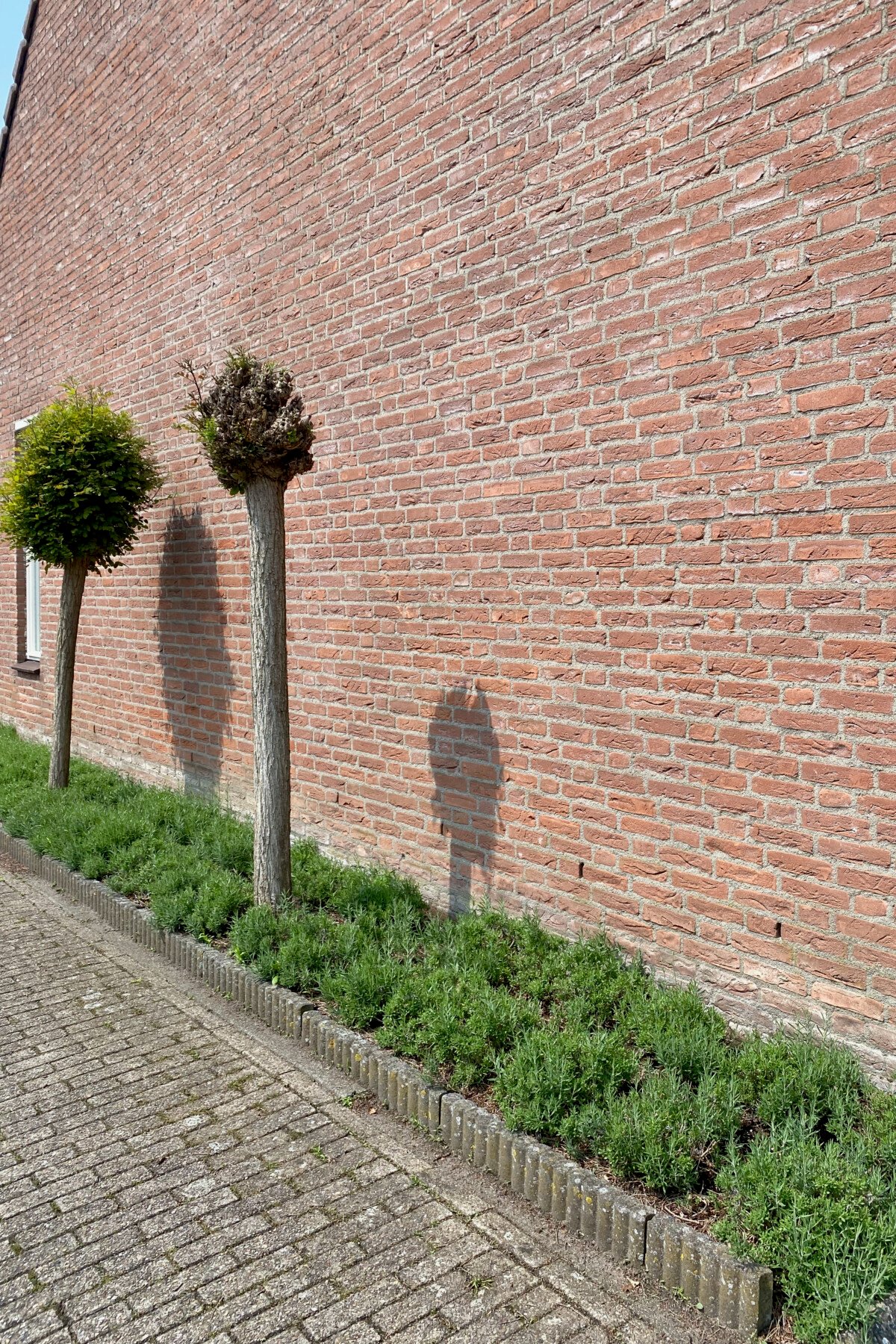
This will have a direct impact on the length of the growing season of whatever plants you choose.
Also keep in mind that a wall stores heat. What will be a plant boost in spring and fall might get too hot in the summer, especially if we’re planting against a south-facing wall.
A second factor in the microclimate variable is precipitation.
Depending on which direction the rain is falling from, the wall might cast a so-called “rain shadow.” This means the strip along the wall might get less precipitation than an open border, for example. It’s not a bad thing, as long as you take it into account when you’re choosing your plants.
2. Think of what soil you have for gardening at the base of a wall.
In my experience, the narrow area at the base of a wall isn’t exactly filled with rich soil. This strip might often be filled with rubble, sand or just leftover dugout soil from construction. Sometimes, the lawn might extend all the way to the base of the wall, so you’ll need to add a bit of topsoil and compost before you plant.
If it’s the exterior wall of the house we’re talking about, and not just a garden wall, you may even have to work around an air conditioning unit, drains or other architectural elements.
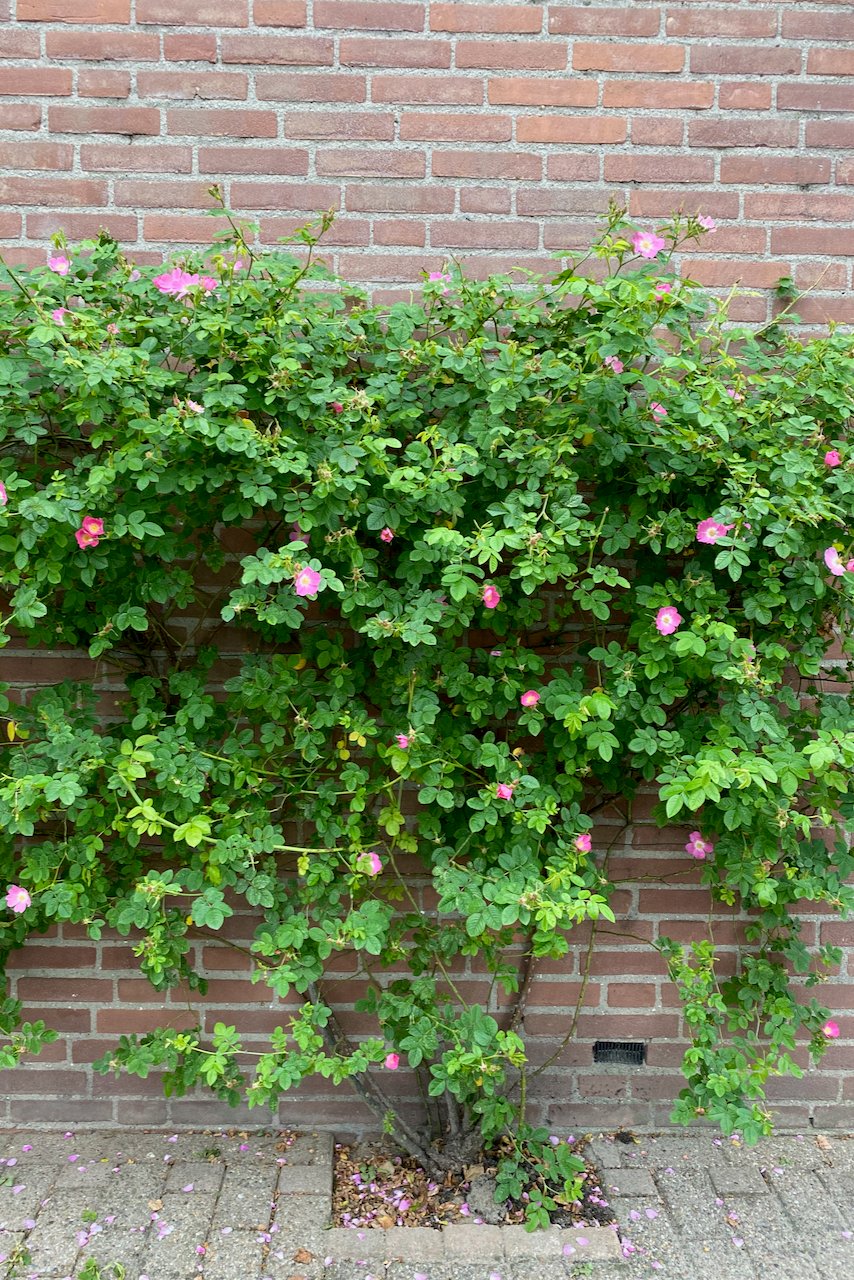
Luckily, unlike the orientation and the amount of precipitation, this is often a factor that we can influence. Start by thinking about what plants you’re planning to put in the ground. Then you can either dig out a couple of inches of the existing soil and replace it with good quality topsoil or compost. Or simply dig in the compost and mix it with the existing soil, if you already have something to start with.
3. Think about the support system of your wall garden.
If you’ll be growing climbers, how are you going to attach them to the wall?
If you’ll be growing shrubs, how will you train them flat against the wall?
If you’ll be growing tall perennials, how will you make sure they won’t flop away from the wall?

I’m a big proponent of as few points of contact with structures as possible. So let’s say you’re growing something that requires a trellis to climb on; it’s better to attach a trellis to the wall (attaching it at four or six points, depending on its size) than turning the wall itself into a trellis (and needing to drill more holes into your walls).
Plants that you can grow against a south-facing or west-facing wall.
First, let’s start with the easier assignment and talk about plants that grow well along a wall in a sunny or partly sunny location. I’ve divided them by category below to include as much variety as possible.
Vines for south-facing walls
Vines are a no-brainer for south-facing and west-facing walls. Most vines have tropical roots, so they prefer full sun coupled with plenty of water. But before you plant out any vines, research which one of the three growth patterns below they have.
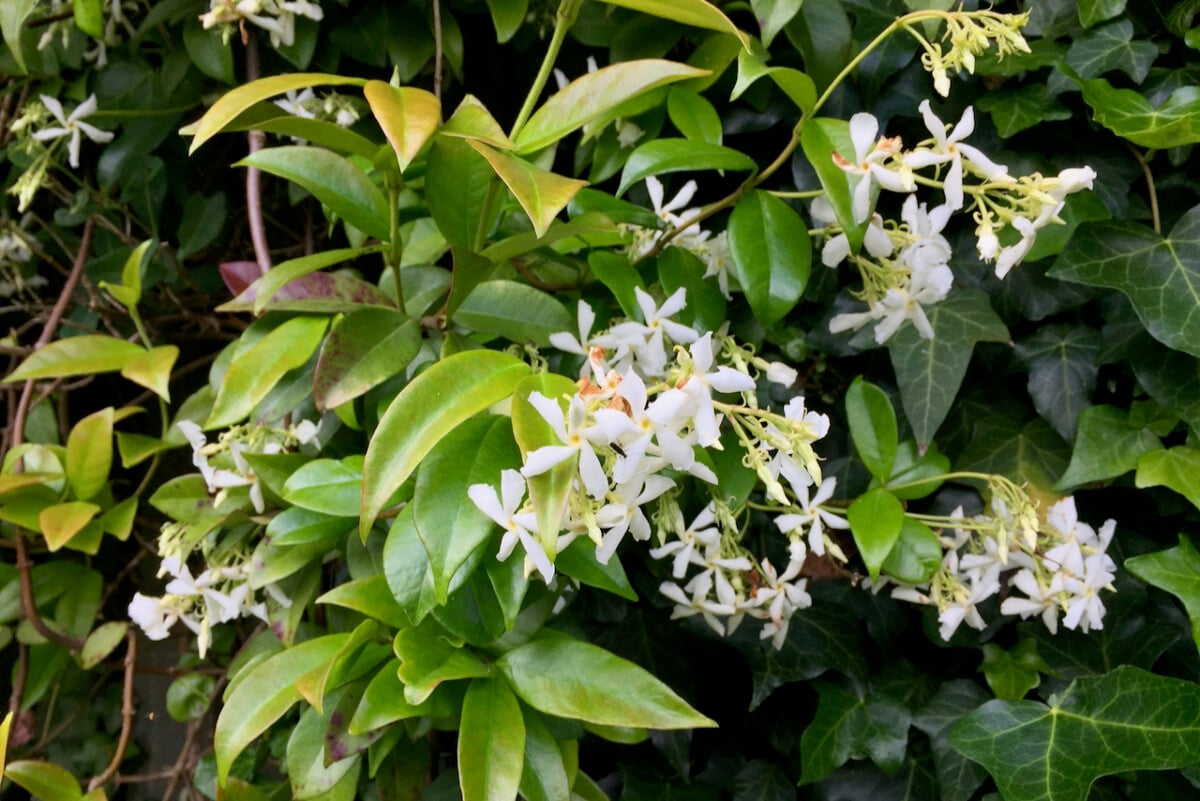
Twining vines, such as star jasmine (Trachelospermum jasminoides) will wrap around a few supports fanned out in a V-shape. They’re relatively easy to grow and don’t require too much climbing ‘infrastructure.’
Vines that attach via tendrils (such as clematis and sweet peas) require a trellis to climb on, so you’ll have to install that before you put the vines in the ground.
I would recommend avoiding clinging vines that send out suckers, such as English ivy. While it will keep your wall evergreen (even in the depth months), it does require constant maintenance and serious pruning to keep it in check. This can get especially tedious in the summer months.
Here are other vines you can plant against a wall:
American wisteria (Wisteria frutescens), but avoid Chinese and Japanese wisteria (Wisteria sinensis);
Coral honeysuckle (Lonicera sempervirens), but avoid Japanese honeysuckle (Lonicera japonica); I wrote about the difference between the two in this article.
Clematis, but avoid sweet autumn clematis (Clematis terniflora);
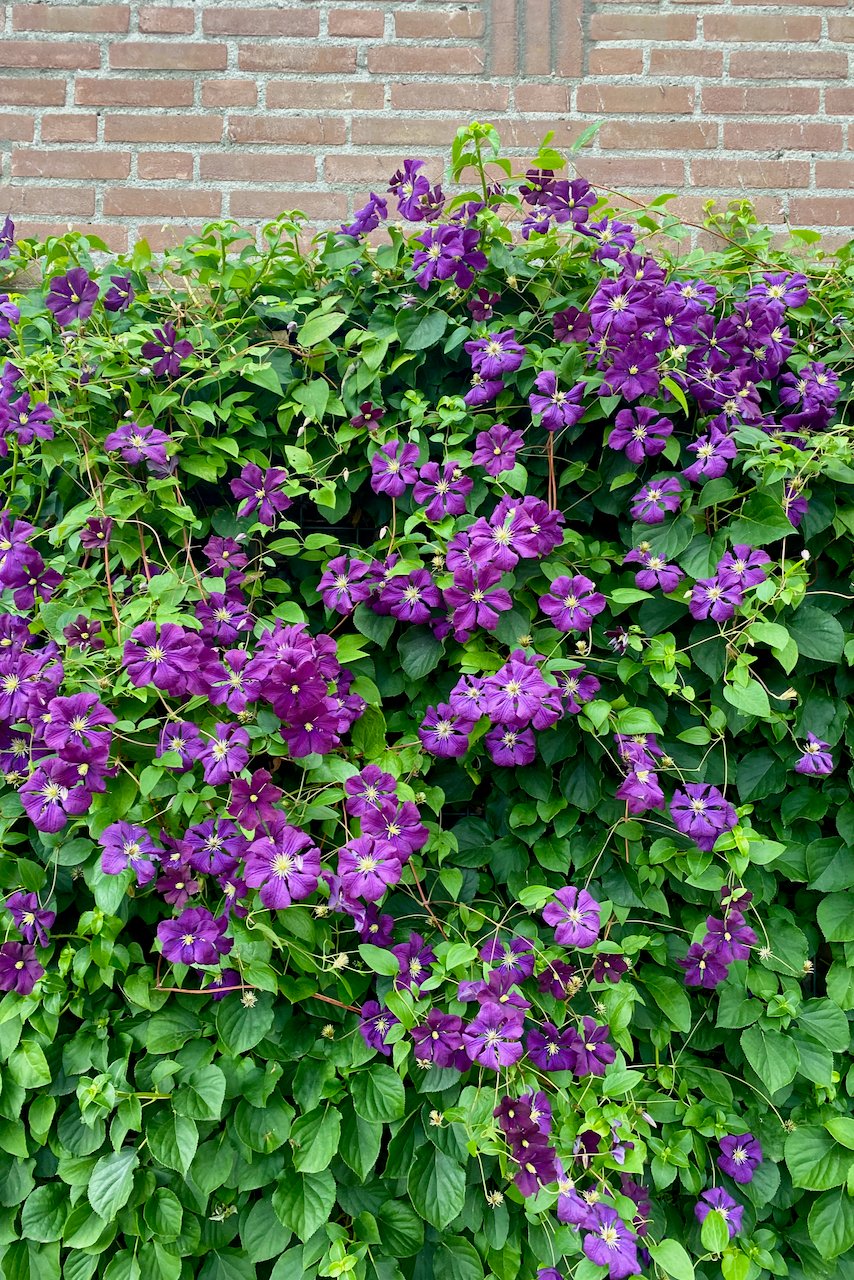
Bougainvillea – they are very drought-resistant, but will not tolerate frost;
Passion vine (Passiflora);
Butterfly vine (Mascagnia macroptera).
Shrubs for south-facing walls
Let me start by recommending climbing roses, because I feel like they should have a category of their own. Unlike climbing vines, roses grow on their own thick stems. However, the stems will still need to be anchored to a support to help them climb.

Roses don’t need too much soil to grow out of, but they do need rich, well-draining soil that you’ll add compost to every year. I especially love cascading roses such as the ones from the ‘Cascade’ and ‘Eden’ series.
Another consideration for growing a shrub against the wall is whether you can train it to grow flush against the wall or prune it in such a way that it will accommodate the surface of the wall. Some popular shrubs, such as camellia and rhododendron, for example, will not tolerate this kind of pruning.
Here are some shrubs that will tolerate shaping really well:
Spindle (Euonymus fortunei), especially evergreen variegated varieties such as ‘Emerald ‘n’ Gold’;
Barbery (Berberis thunbergii) – while most commonly used as a hedge, it’s easy to train it to grow up a wall;
Viburnum comes in many shapes, sizes and colors. I recommend Viburnum odoratissimum cultivars for a delightful fragrance when the shrubs are in bloom;
Oregon grape (Mahonia aquifolium) – an evergreen shrub with beautiful deep yellow flowers in spring that turn into black berries (not edible) in the summer;
Skimmia (Skimmia japonica) – an evergreen shrub with red berries in the winter;
Daisy bush (Olearia)
Climbing hydrangea (Hydrangea anomala subsp.petiolaris) – a self-clinging shrub that only needs a bit of direction while it’s getting established. After that, it will attach itself to the wall without digging into the masonry or siding.
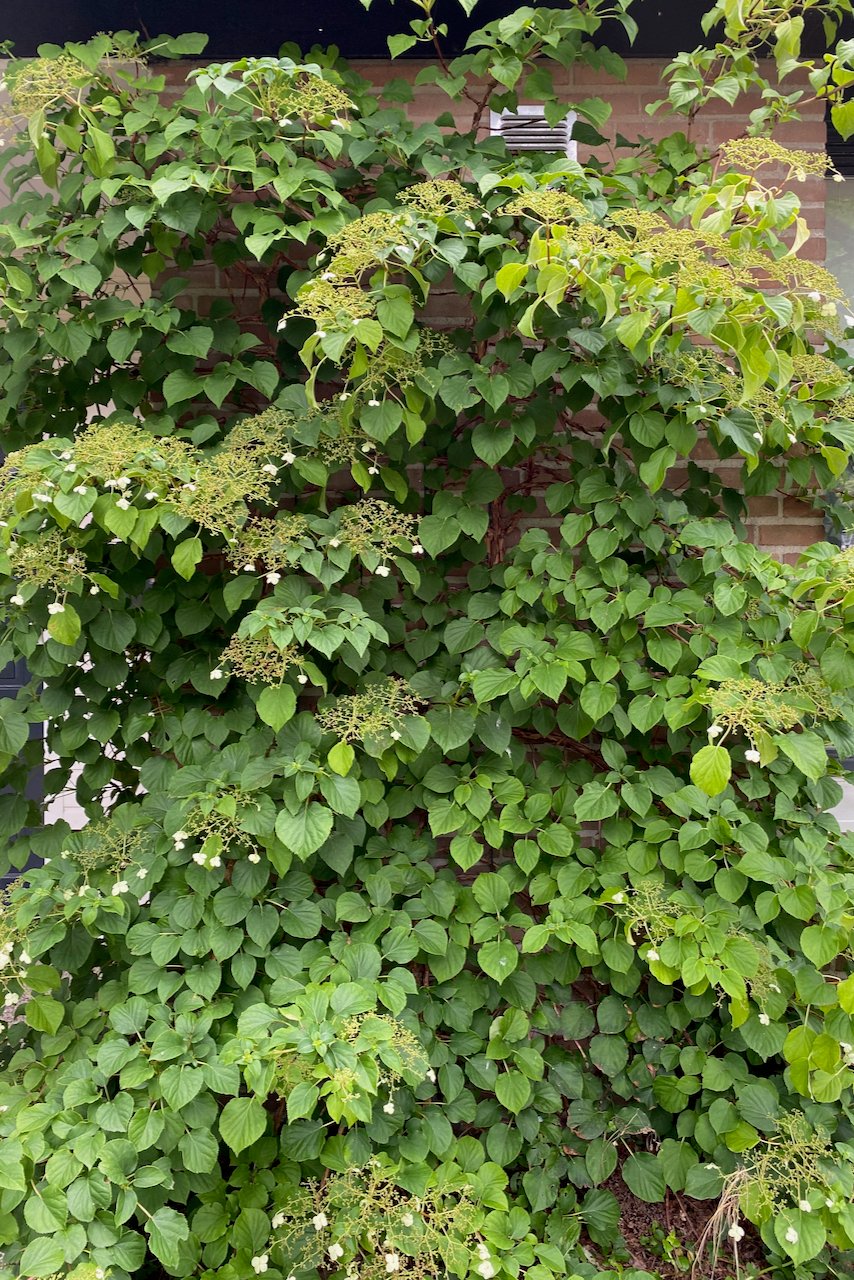
California lilac (Ceanothus) – a long-flowering shrub native to North America; the blooms are blue or indigo;
Christmas berry (Photinia) – a pleasant combination of red and green foliage on the same shrub;
Rockrose (Cistus) – a Mediterranean flowering shrub (often evergreen) that grows really well in rocky, dry soil.
Sea rosemary (Ozothamnus rosmarinifolius) – an aromatic, evergreen shrub that will grow well against a wall that gets hot in the summer
Perennials for south-facing walls
You can grow a lot of herbaceous perennials along a sunny wall, as long as you pay attention to what type of soil they like. Most perennials do well in regular well-draining soil, but it’s often the lack of depth of the flower bed along a wall that may lead to some failures.
Do some research about the type of root that the perennial has and whether or not you can plant it in shallow soil, if that’s what you’re working with.
Another thing to consider with perennials and biennials is their height.
Taller perennials such as foxgloves, hollyhocks, verbena and valerian will need some sort of staking or cordoning off to keep them upright against the wall.
Make sure that you account for that, especially if you’re planting in a narrow strip. And if we’re talking about a garden wall, think about whether you want your plant to grow taller than the wall itself.
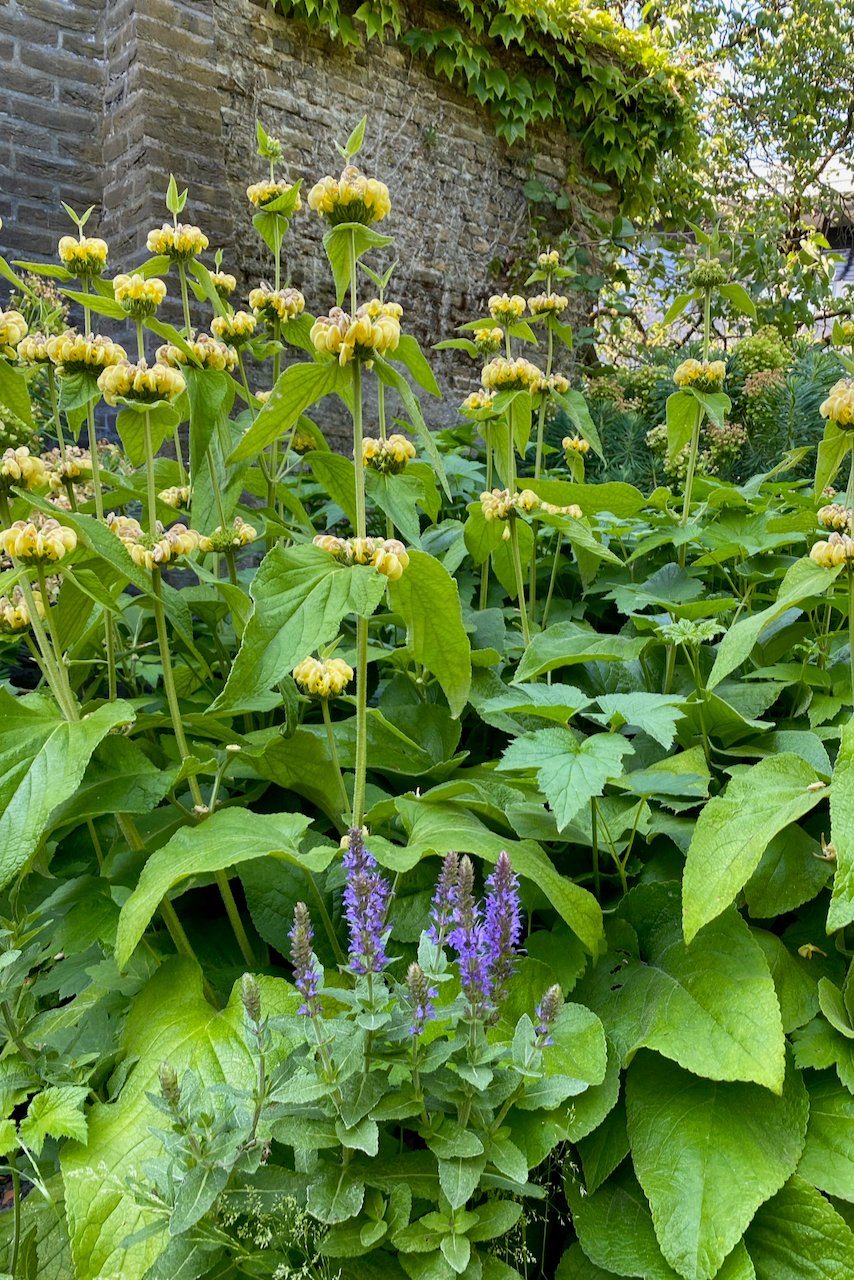
Turkish sage (Phlomis russeliana)
Lavender (Lavandula)
California tree poppy (Romneya coulteri)
Bear’s breeches (Acanthus mollis)
Cardoon (Cynara cardunculus) – an edible perennial that I mentioned in my article on edimentals;
Oregon sunshine (Eriophyllum lanatum)
Sea holly (Eryngium)
Sea thrift or sea pinks (Armeria maritima)

Hollyhocks (Alcea)
Perennial geraniums (Geranium cantabrigiense and Geranium sanguineum, in particular)
Creeping thyme (Thymus praecox)
Tall phlox (Phlox subulata)
Lamb’s ear (Stachys byzantina)
Mediterranean spurge (Euphorbia)
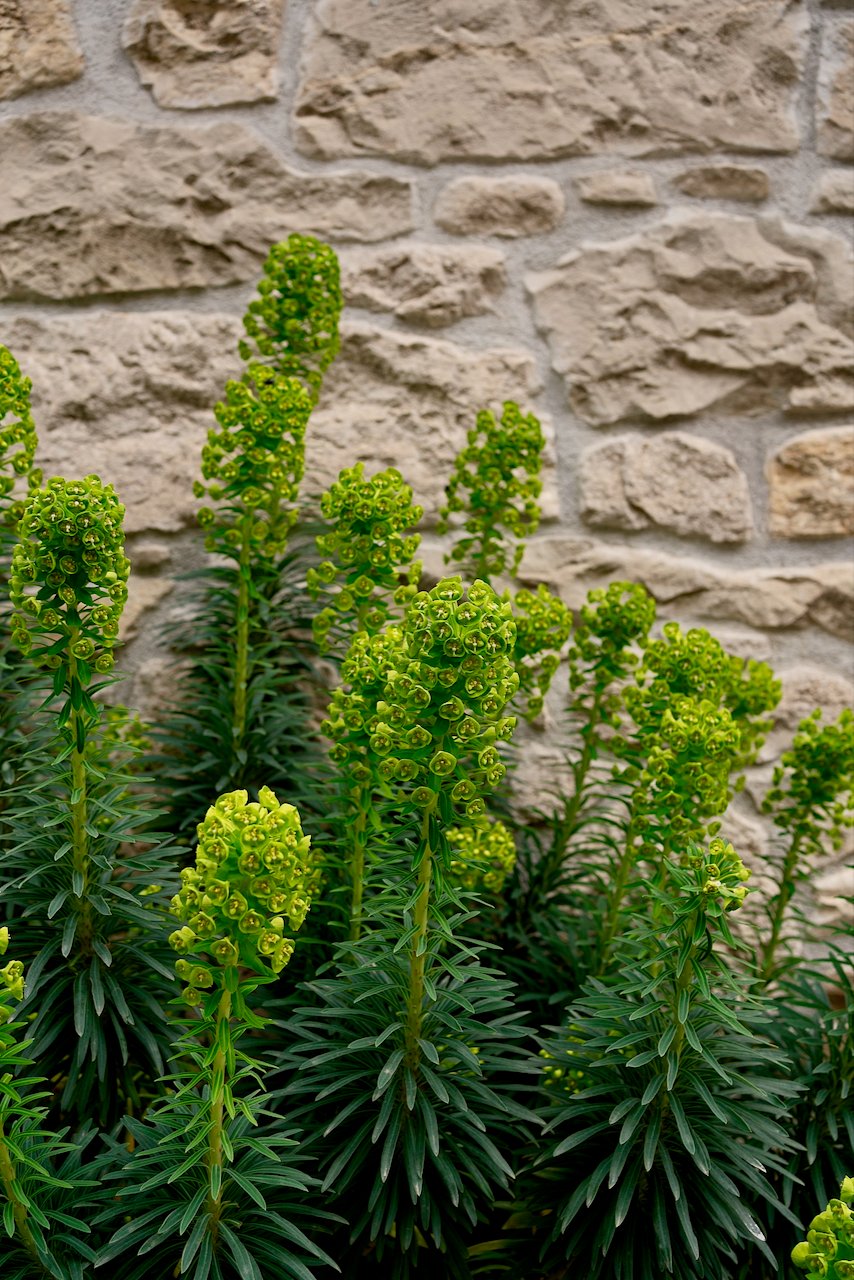
Mullein (Verbascum)
Californian fuchsia (Epilobium canum)
Star of Persia (Allium christophii)
Plants that you can grow against a shaded wall.
Planting along an east-facing or north-facing wall can be a bit tricky because the plants get at most a couple of hours of sun a day. Often, not even that much.
So it’s no wonder that I usually see shaded walls left neglected and unadorned with any type of plant. (Except, in a best case scenario, some moss patches).
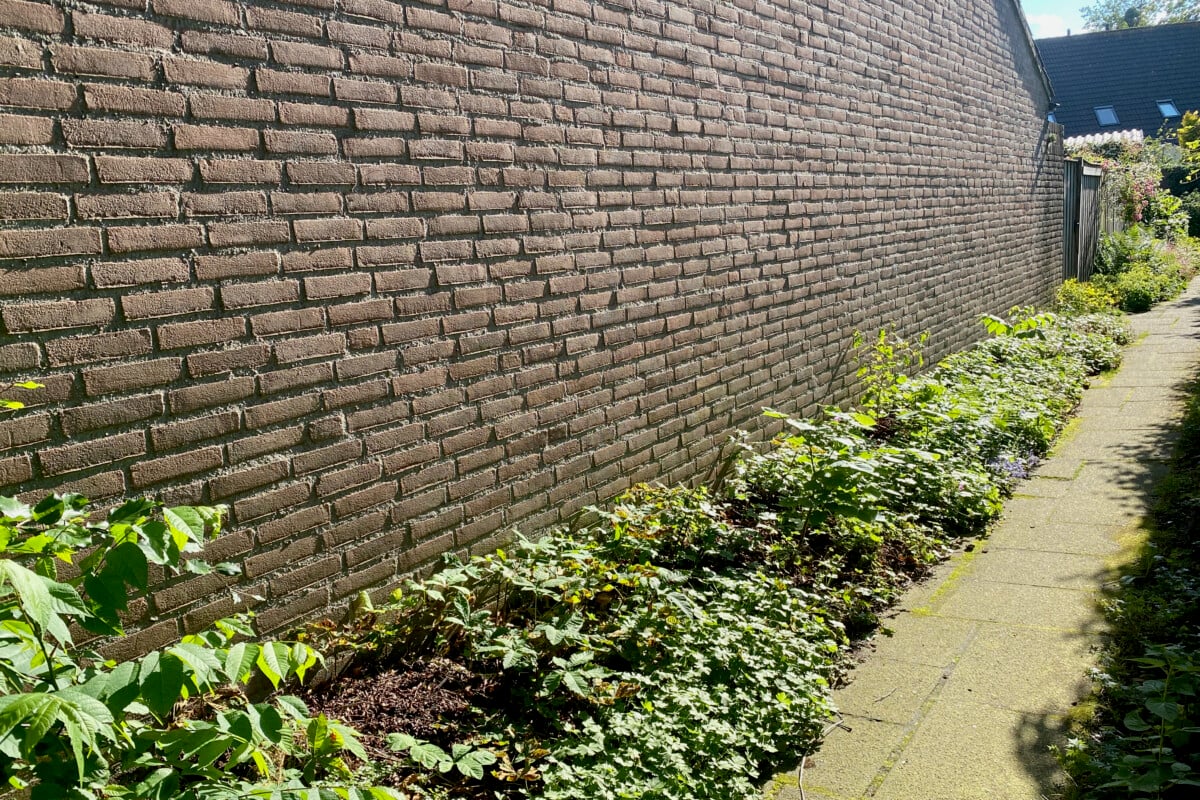
The range of plants we can choose from is not as wide, but it’s not impossible to turn a shaded wall into a green wall.
I won’t start with flowering vines this time because I don’t want you to waste your money and be disappointed. The truth is that planting flowering climbers against a shaded wall is pointless.
These tropical vines won’t get enough sun or enough heat to reach their full potential. Yes, you might get some clematis flowers, for example, but they’ll be so sparse that you’ll constantly be left wondering what you’re doing wrong.
I’ve been there, I’ve done that, I’ve transplanted the clematis to a sunnier location and then watched it take off.
Shrubs you can grow along shaded walls
Here’s the good news though: even though flowering vines are off limits, you can still bring color and texture to a shaded wall by using shrubs.
Firethorn (Pyracantha) – produces waxy fiery berries in late fall and early winter; depending on what cultivar you’re planting, the berries can be yellow, orange or red;

Barberry (especially the smaller ones, such as Berberis microphylla and Berberis stenophylla)
Cotoneaster
Butcher’s broom (Ruscus aculeatus)
Skimmia (Skimmia japonica)
David viburnum (Viburnum davidii)
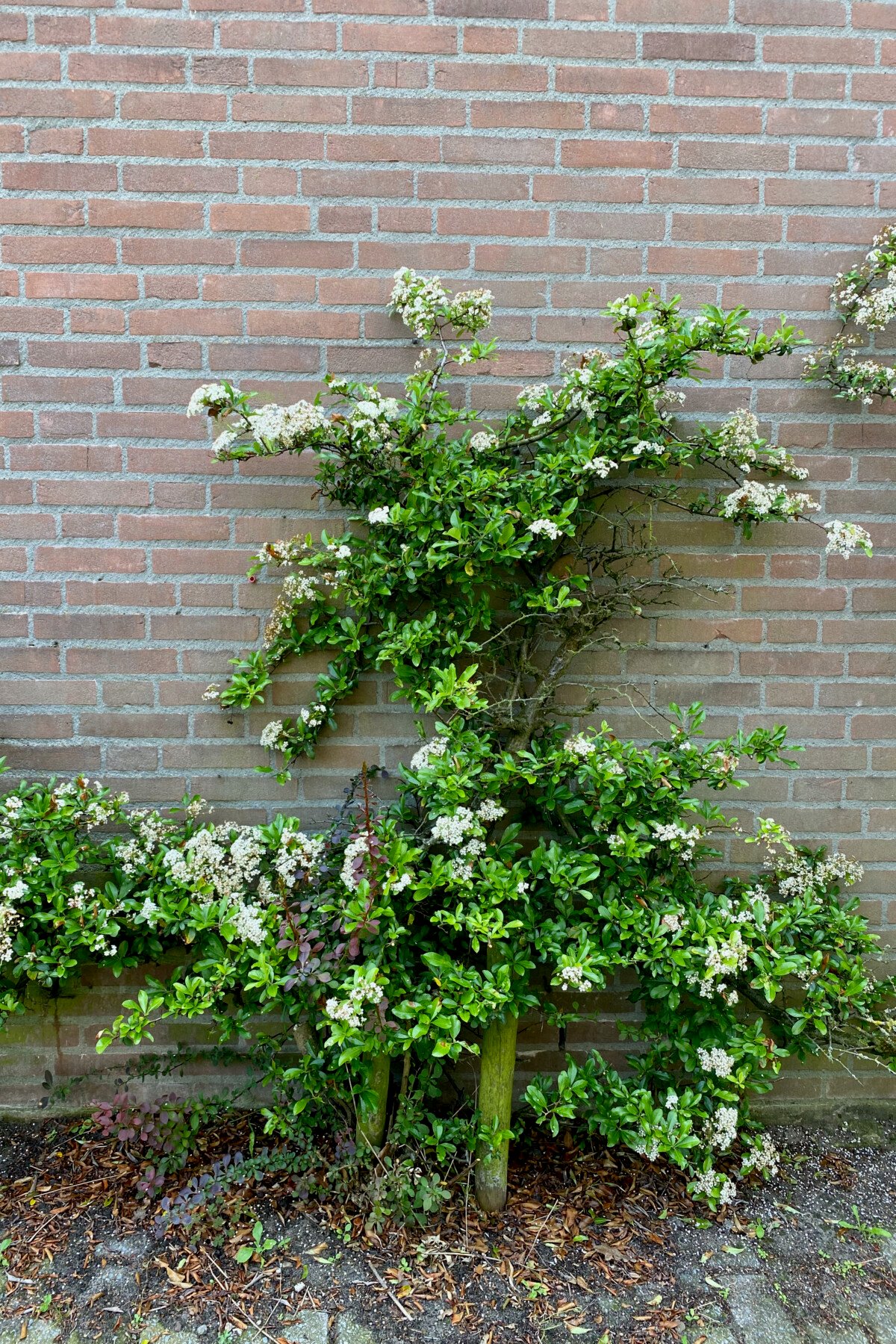
Variegated spindle (Euonymus fortunei)
Spotted laurel (Aucuba) – an evergreen shrub that produces (inedible) berries in the fall;
Ferns
Here’s a gardening treat that you can only grow in the shade: ferns. But keep in mind that ferns like moisture, so planting them in dry shade is not ideal.
There are hundreds of types of ferns suitable for gardening, so it can be hard to get started with them. I advise you to first research whether there are any ferns native to your area and whether you can find them available for sale.
If there aren’t, here are a few ideas to get you started.
Maidenhair fern (Adiantum capillus var. veneris)
Himalayan maidenhair (Adiantum venustum)
Hart’s tongue fern (Asplenium scolopendrium)
Male fern (Dryopteris filix-mas)
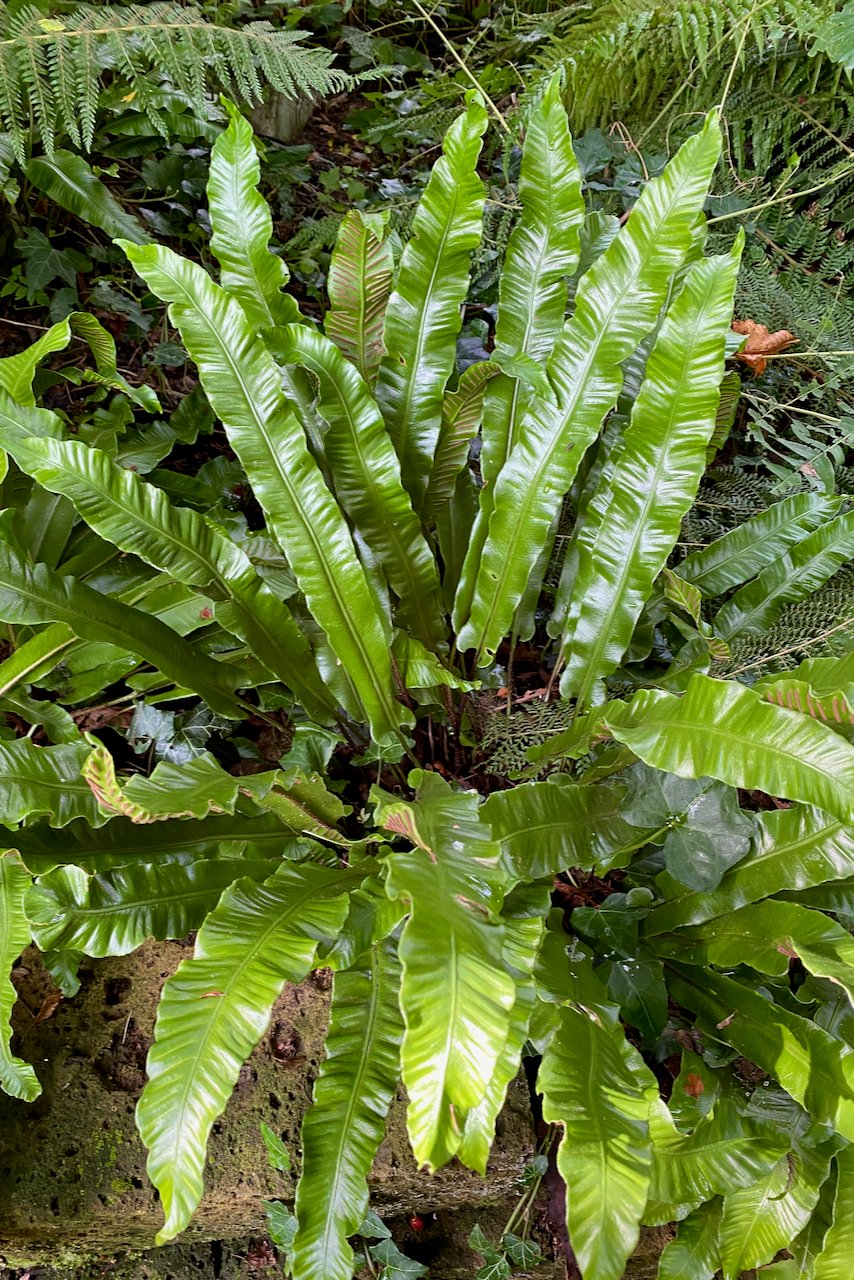
Limestone polypody (Polypodium cambricum)
Soft shield fern (Polystichum setiferum)
Painted lady fern (Athyrium niponicum var. pictum)
Sensitive fern (Onoclea sensibilis)
Perennials to grow along shaded wall
Generally, any perennial that grows well in a shaded bed will grow well along a shaded wall. And if you can’t grow tall perennials, have a look at groundcovers and shorter mounding plants such as hellebores.
Lady’s mantle (Alchemilla mollis)
Monk’s hood (Aconitum carmichaelii)
Astilbe
Lungwort (Pulmonaria)
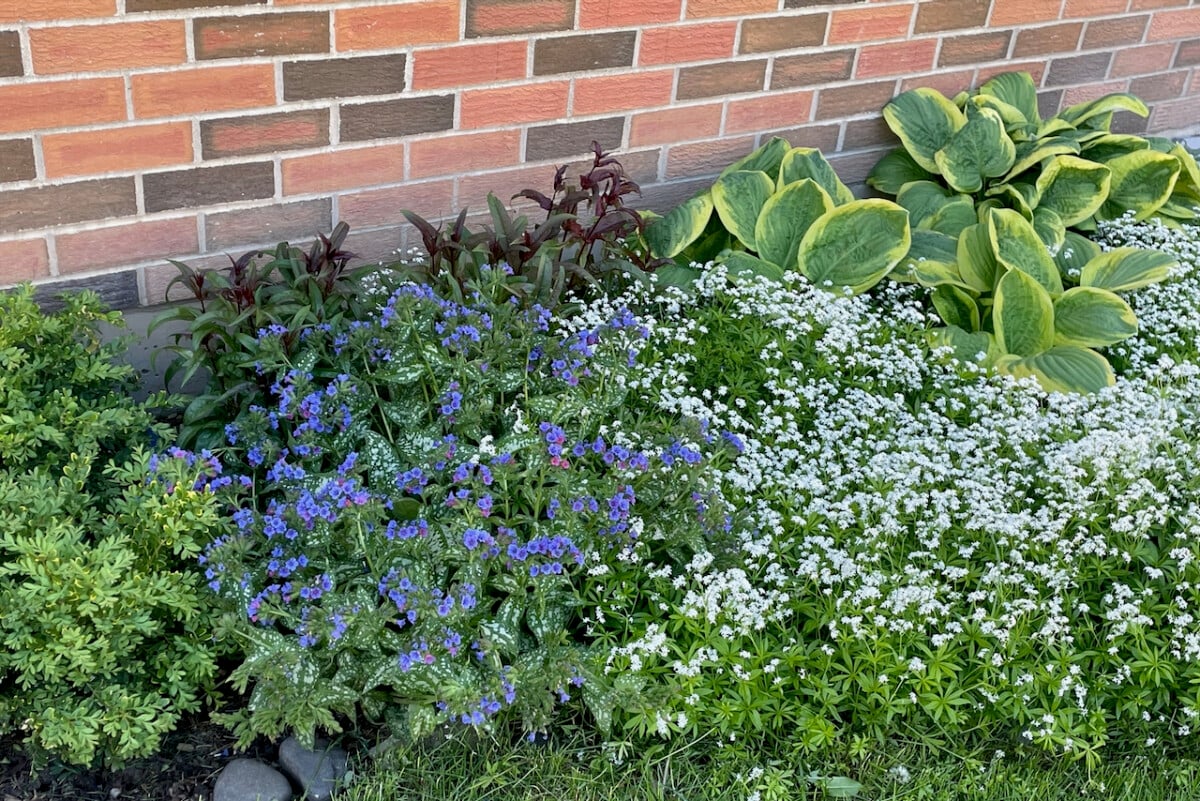
Ligularia
Fall anemone or Japanese anemone (Anemone hupehensis)
Hellebores (Helleborus)
Aralia (Aralia cordata)
Straw foxglove (Digitalis lutea)
Bugle (Ajuga reptans)
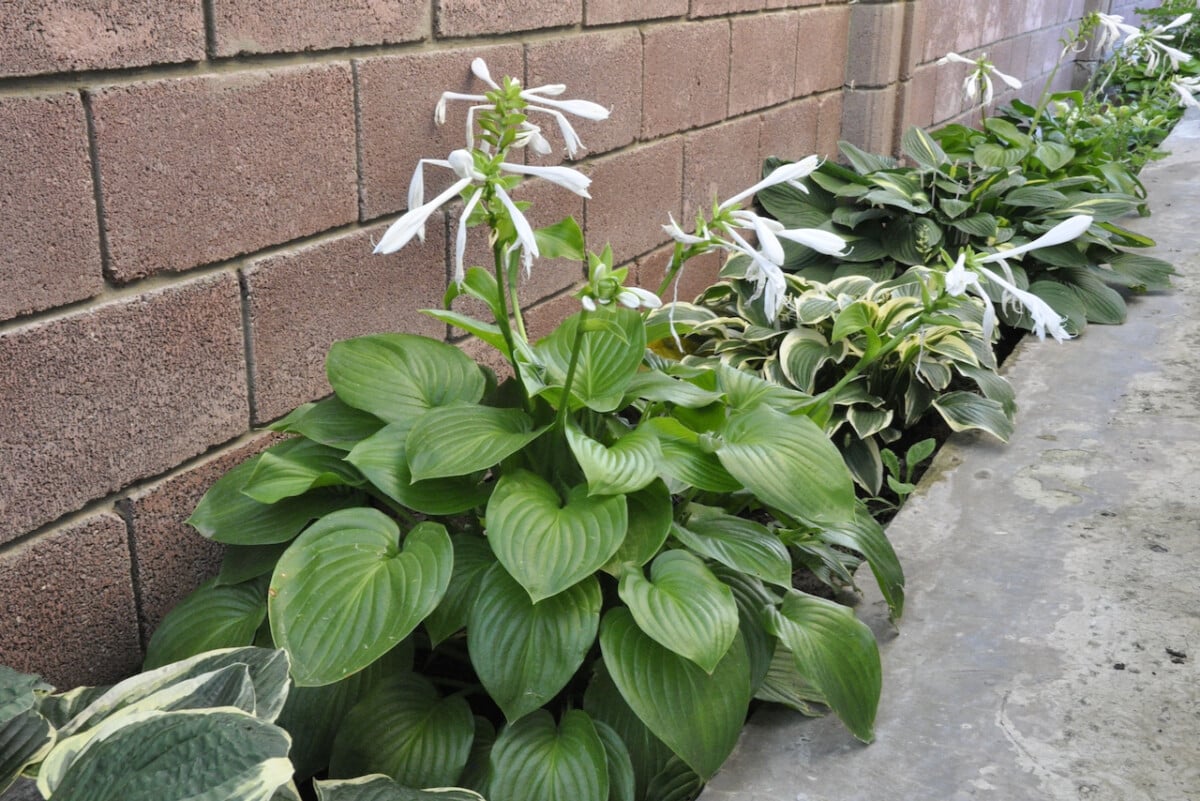
Foam flower (Tiarella wherryi)
Willow gentian (Gentiana asclepiadea)
Blue lilyturf (Liriope muscari)
Meadowsweet (Filipendula ulmaria)
Mock strawberry (Fragaria indica)
Barren strawberry (Waldsteinia ternata) – an evergreen groundcover
Globe flower (Trollius)
Meadow rue (Thalictrum)
Pacific bleeding heart (Dicentra formosa)
I hope you find this article encouraging, not intimidating. There are plenty of plants that will grow well next to a wall, whether it’s in the shade or in the sun. And if they don’t, you can always apply the general rule of gardening: try again, try something else, see what happens. Good luck!

